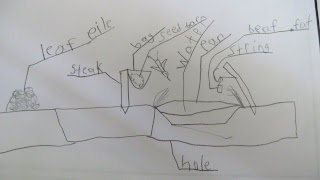We are participating in the Outdoor Hour Challenges (although we are a little behind!), so we headed out earlier this month to see what birds came to our summer feeders, and to choose one for further study. My youngest selected the raucous Blue Jay for his study, and we found Outdoor Hour Challenge #2, "Jays and Bluebirds."
We see Blue Jays regularly at our summer feeder, but not as frequently as we do at our winter feeder (which is why we included a winter photo here, of a little feeding study we did while we were in the kitchen baking on winter day). They prefer more woodlot for breeding than we have near our city lot.
We are using Apologia Science's Exploring Creation with Zoology 1: Flying Creatures of the Fifth Day for a science text book this year, so we are learning about scientific nomenclature, and made this the focus of our bird study. When we consulted the Handbook of Nature Study, we found that crows and jays were closely related; our field guide told us they were both in the Family Corvidae (Crows and Jays).
We studied the Blue Jays that came to our feeder, as well as their more numerous cousins, the American Crows. We focused our observations on the features that made them similar, and the ones that were different, by comparing the crow and the jay, using a Venn diagram with categories: beaks & feet, color, food, size, habits and body shape. Adding comparison categories to a Venn diagram makes the comparisons more meaningful than many children will make without these prompts.
We also closely examined the Latin name for Blue Jay, because we learned that the Latin name for an animal describes it so that any zoologist in the world knows some basic information about it, just by its name:
Cyanocitta cristata = blue, city, crested = blue, crested bird that you find in the city ... pretty accurate!
 We will be continuing our studies of the blue jay and other feeder birds this month, and will add more detailed observations, making a field journal, doing a feeding experiment, and listening to the calls and songs of our feeder bird friends. We have been using the bird study sheets from the June newsletter (from the Handbook of Nature Study), as well as bird study notebooking pages from the Notebooking Treasury (see their sale coupon, on the sidebar, for Back to School Savings!).
We will be continuing our studies of the blue jay and other feeder birds this month, and will add more detailed observations, making a field journal, doing a feeding experiment, and listening to the calls and songs of our feeder bird friends. We have been using the bird study sheets from the June newsletter (from the Handbook of Nature Study), as well as bird study notebooking pages from the Notebooking Treasury (see their sale coupon, on the sidebar, for Back to School Savings!).If you want a fun activity to do with your kids, that will reinforce how living things are classified, check out "Taxonomy Fun," a PBS page that invites kids to sort photographs of animals and state their "rule" for classification. You can also do this activity using photographs from nature magazines.
National Geographic always has a ton of great information for kids to use for online research. Check out their page on the Blue Jay, for photos, videos, calls and songs, and lots of information for further study about Blue Jays. For example, did you know that young blue jays often stay with their parents for more than one year, helping the parents to tend the next year's batch of babies? Also, if you find a blue jay nest, you will discover that the mother blue jay likes to add interesting objects, such as twist-ties, colorful plastic food wrappers, and shiny pieces of foil, to her nest of sticks. And the normally boisterous jay sits perfectly motionless and silent, if you happen upon the nest when mom is sitting on her eggs.
__________________________________________________
I've updated some of my other articles on observation:
Science Skills: Making Observations and Asking Questions Like a Scientist now includes additional links, updates and class pet ideas. Come and see the new module on easy class pets (all tried and true, based on my classroom experiences!). Check out some unusual critters to keep in the classroom, and my list of not-so-great class pets. Additional links to websites and downloadable resources also included.
The Power of Observation: Life in a Tiny Ecosystem has new activities, and new content, as well as
additional links to blogs and notebooking resources on mosses, lichens and fungi. Check out the discount links to notebooking pages you can use with this activity and other nature study projects, and try my new poll on science process skills.
If you missed my last blog post, check out our study of shark teeth and other beach combing activities, in Beachcombing, Part I: Shark Teeth.
_______________________________________________________
What does it take to be a great teacher? See The 12 Qualities That Great Teachers Share, from the Washington Post.






















